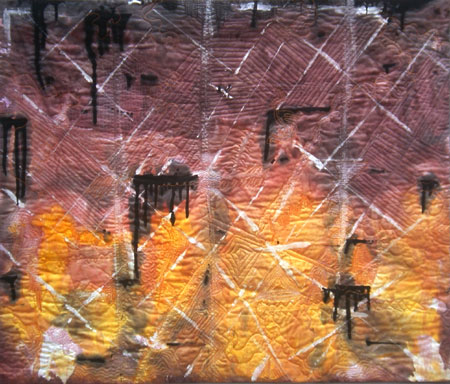
Farmland, 36 x 43, painted cotton
I have lived many places, and in each, I have always had a strong sense of the place itself — the trees and plants, the nature of the cultivated earth, the nature of the uncultivated earth, the sky, winds, air, light — I can describe all these with a fair amount of detail.
But I seldom had to try to recap in art what I know about a place where I no longer live. However, now I am doing so.
“Paint what’s around you,” seems to be a sound admonition, but what is around me is the opposite, environmentally speaking, of what I am painting.
I live in Portland, Oregon, a small American city in which the streets lie in grids and the foliage is heavy, dense, green, overwhelming the sidewalks and enveloping houses. The lush warm climate makes geraniums grow like bushes and Firethorn take over the yard.
But — I’m trying to stay immersed in and make art from the other side of the Cascade Mountains, a high dry land which smells of dust and sage, where each plant has its own space in which to grow. Sometimes I feel like I’m being tugged and torn by opposing visions, smells, sights, memories.
Here’s a couple of street scenes from Portland Oregon in June:
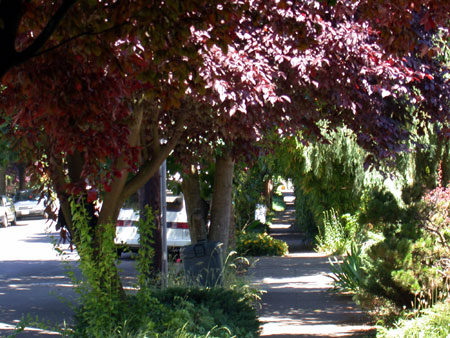
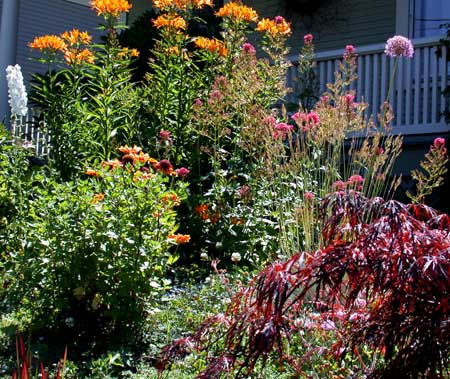
And here’s a 2002 piece based on these streetscapes. It’s called Where I Live and is discharged and appliqued cotton.
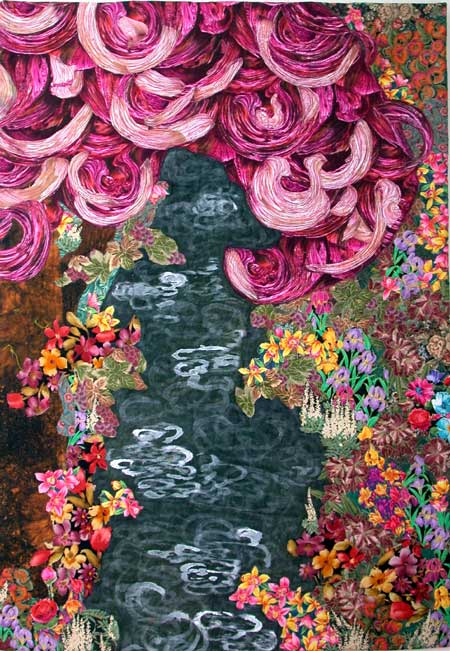
Here are other photos from Portland.
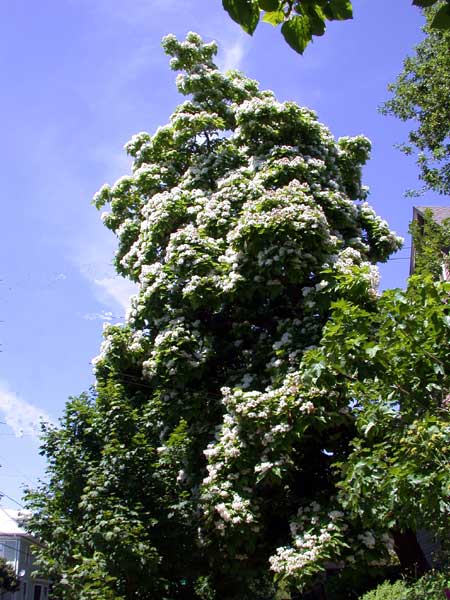
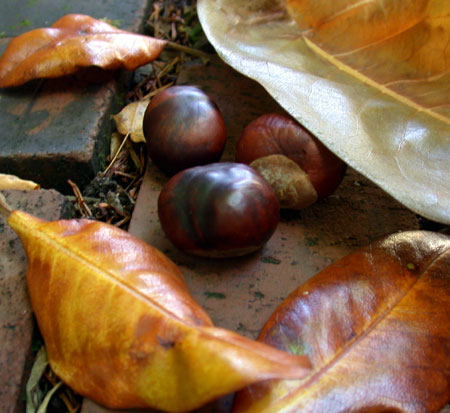
And the piece below, from 2003, is Consider the Horse Chestnut, is 39 by 50 “, digitized and pieced computer prints on silk.
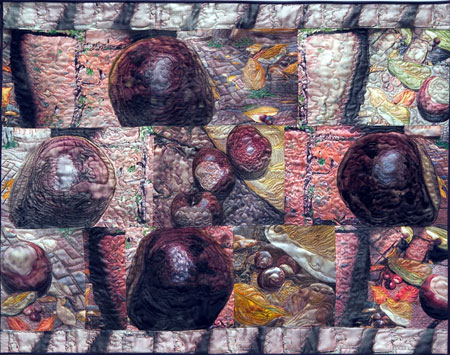
Those pieces were done in 2002 and 2003, before I became enamored of the landscapes of the high desert.
Below are photos from my current obsession: the photos are from the John Day Fossil Beds in eastern Oregon, across the wild Cascades, in the land of rabbit brush, rattlesnakes, sage brush and cows.
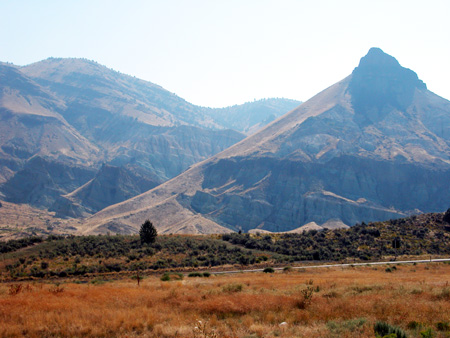
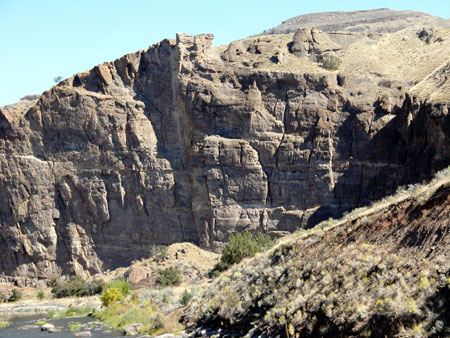
And here is some art that I’ve done from these places: below is a piece called Above the Cant Ranch, 28 x 38, painted cotton.
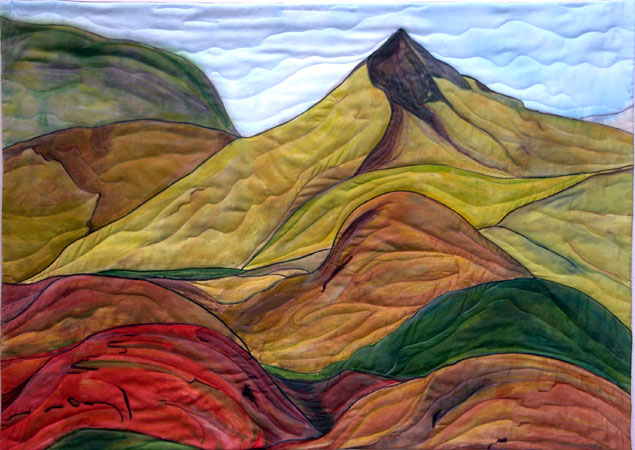
And below is The Mother of Us All, 53 x 55 inches, painted silk.
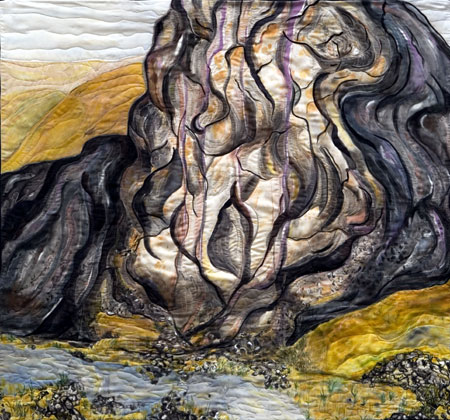
I’ve been fascinated by the variety of “takes” that people on Art and Perception have on their own senses of place. Some of the artists here work out of very specific scapes. Richard, Steve, Doug are all exploring physical forms that they encounter. But Karl and Angela seem to be working out of memory and imagination and stored visuals, which they combine to form new uncanny landscapes and shapes. Sunil works from images he sees in the media; Jay plays jazz-like rifts on items he comes across or thinks about. Leslie makes use of our heritage in the visual arts.
How do Karl and Angela maintain their vision of their figures through the various incarnations. Can Steve make the Bitteroot mountains, encased with air, follow what he has done with the solidity of the rocks of the Anazasi?
Meyer Shapiro says that Cezanne “is attached to the directly seen world as his sole object for meditation. He believes — as most inventive artists after him cannot do without some difficulty or doubt — that the vision of nature is a necessary ground for art.”
Is the vision of nature a necessary ground for your art?

I’d note that “nature” and “place” are not synonymous; as I’m writing my artist statement (yes, still working on that…), I’ve realized the latter is the common theme for me. Traditional outdoor landscape places are my norm, but I’ve also been interested in interior places (e.g. ghost town buildings) and in cityscapes. More later.
Another quick note: David Palmer seems to transform landscape the most of any of us, for example in his Flatland series. I’d say nature and place certainly matter, though not usually specific places. See pictures and read the interview here.
June:
Hola.
Some little quick things: was it Farmlands going in or so upon standing back and observing the results of your labors? I might guess the former, while not dismissing the latter. Personally, I have a feeling for the particular greenness of Lancaster County, Pa. , but I doubt if I could reconstruct it from memory alone.
Or could it have been a mid-course thing, where the abstract progress of your colors, began to speak to you of places remembered?
Is the question important?
Jazz?
Come to think of it, Cezanne did hew to the motif. But what he did to his son in his Harlequin paintings or to most anything in his later watercolors, would suggest that he was taking a long lead off first base.
Steve,
Interesting, the difference between nature and place. I suppose that I carry something of my “artificial” space (books, art, husband) with me, so that space remains more constant than does the nature surrounding it.
When you say, “I’d say nature and place certainly matter, though not usually specific places.” are you speaking of your own work or art in general?
I hadn’t thought of David Palmer’s work in terms of landscape — it’s like the fly-overs or the GPS sightings — the view from above.
Jay,
“Farmland” (2003) fits between the earlier city-scapes and the John Day stuff. It’s based on my memory of summer light over the fields along the Susquehanna River — a light I remember from when I was about 8 years old. So it’s definitely a memory place, although I could take you to the spot with no trouble, all these years later.
June,
The comment related to David’s work. For myself as a photographer, my work is always about specific places, though it can certainly allude to ideas of place more generally. Unfortunately, I haven’t learned how to make a photograph from memory. But I relish the thought of going back to photograph in places I formerly lived. Had only one too brief chance to do that so far.
The thought I’d like to raise is: can a work of art be just about place? Isn’t it just as much about the artist who sees the place in the way depicted? Perhaps an obvious point, but one that often seems ignored.
“…how to make a photograph from memory…” Yes!
June:
And the farmland may have been on that island in the Suzy-Q, crossed by a road and two trestle bridges.
Cezanne: I know of some paintings of his where the motif is rather generalized – perhaps a stream with foliage to mention an example at the CMA. Otherwise, he seemed to like subjects with monikers. Maybe one could add to Meyer Shapiro’s statement: “the nameability of nature”.
Jay,
I may be influenced by what I’m reading on Cezanne — Erle Loran’s “Cezanne’s Landscapes”, Pavel Machotka’s “Cezanne: Landscape into Art” as well as Meyer Shapiro’s “Cezanne.” All three of these writers emphasize Cezanne’s use of place — the first two have photographs of the specific angles from which he painted the motifs and Machotka, in particular, is careful to find a frame that seems to capture as much as possible the frame that Cezanne is using.
The Cubists and later abstract painters found Cezanne’s techniques (the “patches” and flattening of the space) to be what influenced them, but like myself (insert snort), Cezanne seems to have to have a literal space, which he then manipulates.
What’s the title of the stream with foliage that Cleveland has? The plates that I have seen almost always name the motif or spot that he’s painted –Mont Sainte Victoire, House in Provence, Chestnut Trees at Jas de Bouffan, Road at Chantilly, Chateau de Marines and so forth.
But no, the farmland in “Farmland” was not on the Susquehanna Island downriver from Lock Haven. But it wasn’t too far from that — think the Pine Station Road just before it headed uphill over Pine Mountain. I think the field was owned (or at least farmed) by Bob Johnson. The plowed furrows were delicious to walk in in bare feet. And the river’s edge was a forbidden dark menacing place that smelled bad.
D (and Steve)
To take your comment far more seriously than you meant it, aren’t many photographs really attempts to capture a sense of the place, perhaps evolved out of memory. It’s true you still need the camera and the camera imposes certain restrictions, but I dare say that the frame that the photographer picks up is as much based on memory as it is on the thing, the “motif” itself.
On the other hand, perhaps we all are waiting for the time when implants in our brain pick up electrical signals that can be digitally translated into physical artifacts. Give it a couple of years.
June.
My “Yes!” was entirely serious.
My feeling is that one does not experience a place by simply revisiting, but more by imagining.
Ah, D., excellent. Sorry I misread you, but happy to have the clarification.
June:
Erle Loran! I was trying to come up with that name. Took pictures of sites, which for their quality as images, are the very antithesis of Cezanne. Of course, they were record shots and poorly served by time, I would imagine.
Who was that other guy – Roger Fry? My memory fades.
The painting in question is entitled “The Brook”, 1898-1900.
one does not experience a place by simply revisiting, but more by imagining
Yes, but to create a work of art, one has to do more than imagine for oneself, and for photography one has to actually go there or construct some simulacrum. In a sense, going there, with your memories along as well, is a combination of reality and imagination. This is why I like to go back to places repeatedly; the experience keeps getting richer.
S,
I agree (12). (The construct is what is, to me, interesting).
June,
I’m struck that your John Day works (rather like most of my own landscapes) are mostly of distant, large-scale things like mountains and rivers, while your Portland pieces are more of smaller things like flowers and chestnuts. Do you think adding a bird or a branch or a foreground rock would work in any of the John Day quilts? Aren’t those just as much part of the essence of the place?
June and Steve:
The lack of birds, branches and foreground rocks is exactly what I admire about your work. As a phototyro I am always in search of the odd foreground element to mask my lack of distance command. In your case, Steve, It’s the overarching sense of space that your marching progressions create. Stick a fencepost in there and your pictures bid to become very -esque. I want my vision to fly out there unimpeded by pictorial conventions.
June, I’ve said it before – it’s as though you are attempting a pictorial purchase on the rocks. One can imagine, in some future millenium, that they could find you embedded among the strata. And they might marvel, not knowing that you crawled in there with your eyes, or marvel more for the knowin’of it.
Such a phenomenon can stand without props.
I have been reading and rereading this post since yesterday and I feel silly when I try putting into words how it fits in with my experiencing the diverse nature around me.
I am at one of my favorite places – the Sleeping Bear Dunes.
Jay,
Thank you for putting into words some of what I’m trying for. I like to think of myself as trying for a perch or purchase (in the climbing sense) on these formations. One could easily become another bone among the bones.
Steve,
Aside from the obvious problems with adding trees and birds or whatnot, which is that they are quite sparse in September in that large silent looming land (junipers are the trees; an occasional hawk the birds), a bigger part of why I disregard the “picturesque” is that I am trying to project or paint or evoke a landscape that is out of our time, our space, something that has no temporal references. Even trees are a bit too mortal. There are one or two landscape features of the 8 that I might include something of human or animal — Cathedral Rock (sigh, doesn’t every mountain park have one) may have to include the road that winds on the other side of the river, preventing humans from approaching it. And it’s possible that I’ll do something on the more cultivatable landscape, the meadows along the river where the cows roam.But they are still in my future plans.
Your earlier landscapes, Steve, are littered with human remains. The Bitterroots (the most recent photos you’ve posted about) aren’t, although I need to go back and look again — were there fields there? At any rate, your themes seem to come back again and again to loss, absence, disappearance, but with remnants left behind to remind us. All done rather abstractly, of course, but still there. Even the waterfall of one of your photos is a more temporal thing than the sheer rock abstract of others of yours. Clearly it’s not an all-encompassing theme for you, but it’s hovers around a lot of what you do.
So I think, alongside of the consideration of the “picturesque” and what is “really there” is the consideration of what it is that one is trying to evoke. Exactly what D., I think, was talking about — the construct.
Birgit, I thought of these queries (for myself) when I thought of your Dunes. The question for me would be what is it about them that I would want to deal with? Why would I be attracted to them? Dunes are interesting because they are both timeless and easily imprinted and then the imprints get brushed aside in a gust of wind or a torrent of rain. And people can make their marks on the dunes, settle into them, and yet when they leave, the great emptiness remains. The sense of great distances that one can observe from the top of some dunes, and the isolation that I remember in your earlier photo — these resonate with me. I don’t know your art well enough to know what is working on you, but you do keep coming back to the Dunes. They clearly are meaningful.
June, Birgit and Steve:
Plucking at the fabric of your thoughts and deeds, which I hope more reveals than ravels…
In what I have seen of your images, Steve, and perhaps too few to measure by – life as clumps and patches serves to punctuate a great process. It’s a sense I get as I had at the Grand Canyon. We stood, the pressing touristy bunch of us, on the lip of a great void made the more empty by the absence of anything of a given size. It was a measure-taking experience and my comprehension could not find purchase.
Sure, a road could cut the Bitterroot and a good explosive charge could topple the balancing rock, but nature does these things in an abundance of time to which we are not privy. I get the sense that a moment – a Steve Durbin – made its flittering appearance as another day among billions began or ended.
June – I was looking at the one picture where a small plateau has bushes. They seem so provisional yet so indicative of a determination to put down roots when at all possible. I realize that my preoccupation with your motif is getting a little long in the tooth – but I go back to your web site which celebrates blossoming things and am struck by the contrast, or the concurrence.
Birgit – drove north along the lake from Holland amid a dynamic landscape. I remember places where the the plants have immobilized the dunes with their cover and others where the shifting sand makes life tenuous. It’s that provisional relationship that I tend to see in June and Steve’s work and I wonder if it plays a part in your response to Sleeping Bear.
Jay and June,
I asked the question about smaller and more transitory elements not by way of suggestion for aesthetic or documentary purposes, but to hear your thoughts, which you’ve expressed so eloquently. As noted, I do not often go for foreground elements, and they can easily look picturesque or overdone or just poorly done. But I do love the few times a bird has flown into a photograph, and wish it were something I could control as June can. To me the contrast would point up the relatively slow time (on a human scale) of these geographies.
Jay’s point about a fencepost (or bird) providing an anchor that affects eye movement and sense of space is well taken. You’re right that in my series with the Bridger (not Bitterroot) mountains in the background (and yes, June, farm fields in the middle ground — there is no near foreground), I am more looking for a sense of sweep that becomes large, flat shapes on the plane. I do have some with fenceposts, sorry to confess. But I think it would be an interesting experiment to take one of these emptier ones and try the effects of different compositions with a digitally added bird. (I don’t do that kind of manipulation in actual images.) Perhaps a future post…
Although I think of myself as a person who is very much in tune with what nature offers and what we can do to sustain the same, the effects of nature rarely speak from my work (focused as they are on individual’s faces). That said, I find the diversity of the subject of my works to be exhilarating. Oftentimes I stroll through streets salivating over certain faces that would look just perfect on a color scheme that I might have cooked up for them on the spot. Nature speaks to me in this way – it is the nature of human species as is revealed by our faces that seem to tell me stories… Each one of us find our own ways of expression – I guess…
I enjoyed looking at ‘Where I live’ over and over again. I would very much like to have it – if it were for sale and if I could afford it. Kindly let me know.